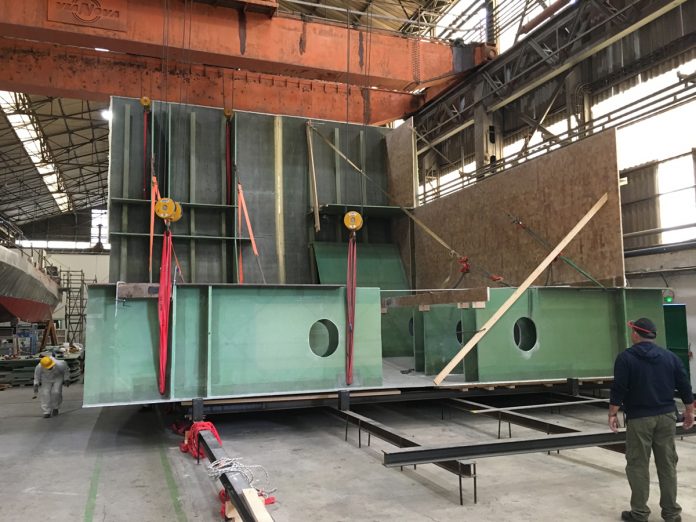FIBRESHIP is a revolutionary European R&D project which attempts to develop a new market focused on the design and construction of large commercial vessels in composite materials to benefit the future of the European shipping and shipbuilding industry
The budget of the FIBRESHIP R&D project is greater than €11 million, most of which has been funded by the European Commission. FIBRESHIP (H2020, Grant 723360) is a revolutionary European R&D project which attempts to develop a new market TO focus on the design and construction of large commercial vessels in composite materials. For the project stakeholders, the use of composite materials results in a significant reduction in the structural weight of a vessel, which implies a reduction in energy consumption, as well as an increase of payload capacity and reduction in operation and maintenance (O&M) costs. This will hugely benefit the future of the European shipping and shipbuilding industry.
Today, most small vessels (below 50 meters length), such as leisure crafts, sailing yachts, or ferries are built using fibre-reinforced polymer (FRP) materials. However, the wide use of composite materials in the construction of large-length vessels is not permitted for the main structural elements of ships over 500 GT (approx. 50 metres in length) due to International Maritime Organization (IMO) regulations by means of SOLAS. This regulatory limitation is attributed to the low mechanical performance of composite structures at elevated temperatures caused by fire events, which can compromise the safety of a vessel. In this regard, the major challenge of this project is to set in motion a new regulatory framework, which allows for the integral construction of large-length vessels made with composite materials, thus enabling its wide application in the shipbuilding industry.
The widespread use of lightweight composite materials in the design and construction of large-length vessels can considerably improve the performance and efficiency of vessels. From the materials perspective, the massive use of FRP in the construction of vessels will result in a significant lightship weight reduction in a range of 30-40% with respect to conventional steel-based vessels. Moreover, the integral design in FRP will suppress the problems of corrosion, which is of critical importance to reduce vessel maintenance costs. From the energy point of view, the substantial weight decrease of the composite-based vessels causes a significant consumption reduction, which induces an important cost-saving in shipping. Consequently, FRP vessels might have a higher payload capacity when compared to standard steel-based ships, which is of vital importance for the practical applications of container ships and other transportation vessels. Last but no means least, the massive application of composite materials in the vessel design is expected to reduce greenhouse gas emissions and diminish the underwater radiated noise (URN), which is of utmost importance from the environmental perspective.
FIBRESHIP consortium is composed of an industrial network of 18 partners, all of whom play a critical role in the European shipbuilding and shipping industry. The partners are divided as follows: three certification companies (Bureau Veritas, Lloyd’s Register and RINA), three medium-sized shipyards (iXblue, NAVROM, and TUCO), four research centres (CIMNE, SOERMAR, University of Limerick and VTT), four shipowners (ANEK, DANAOS, FOINIKAS and IEO), and four marine engineering companies (COMPASSIS, ATEKNEA, TWI and TSI).
The thematic areas analysed in the course of the FIBRESHIP are: (i) The shipping market and business analysis; (ii) Design and engineering; (iii) Material, components and modelling and; (iv) Production and life cycle management. The different tasks of the project are interconnected with each other, providing the required information for the thematic areas.
The shipping market analysis addresses the current situation of the market through a SWOT analysis and evaluates impacts, potential economic benefits and forecasts the widespread use of composites in the construction of ships over 50 metres length, preparing a roadmap of FRP adoption in the European Union (EU) shipping market. Additionally, a cost-benefit calculator is being developed to quantify the economic advantages which will bring the integral construction of large-length ships in composite materials.
An extensive experimental test campaign focused on mechanical, fatigue, and fire behaviour of the composite vessels has been performed to assess the performance of the composites used in fibre vessels. As a result, a composite material selection methodology for large vessels has been carried out, as well as a set of bonding techniques eligible to join ship modular blocks and structural parts.
As an important part of the project, the design of the three-vessel categories most promising for market orientation (containership, ROPAX, and fishing research vessel) is being addressed, as well as the integration and development of different developed numerical models in a unique tool to analyse structural behaviour and collapse events. Consequently, new design guidelines and standardisation rules will be developed based on fire and structural performance criteria.
Likewise, a production methodology to be adopted by shipyards to build FRP commercial vessels has been developed, considering modular subdivision and assembly sequencing recommendations to reach cost-efficient results. On the other hand, different strategies regarding inspection, life cycle and waste treatment for FIBERSHIP solutions are being addressed to evaluate the O&M costs.
Regarding test campaigns, a set of vibration and noise tests were performed in a 35m length vessel in FRP to validate URN models, a parameter of high importance to assess interferences at echosounders and effects on marine fauna, among others. In addition, a full-scale test has been carried out in a containership to validate the developed numerical models and to evaluate an innovative structural health monitoring strategy for FRP vessels in real-time.
As a demonstrator of the achievements and technological breakthroughs of FIBRESHIP, a ship-block of the fishing research vessel (overall length of 85m) designed by TSI, is built at iXblue shipyard. The main purposes of the demonstrator are to prove the feasibility of the construction of a vessel in composites and verify the experimental and theoretical results obtained over the project in a real-scale module.
Thus, the major challenge of this project is to impulse a new regulation able to enable the use of composites in the structure of large-length vessels. The massive use of composites in the design and construction of large vessels will revolutionise the shipping industry due to its multiple economic and environmental benefits.
For further information, visit our website (www.fibreship.eu) or contact the FIBRESHIP Project Coordinator. In addition, the 2nd Public Workshop of FIBRESHIP will be held in Marseille on 25th June 2019 where you can learn more about our achievements in this project. Here, it will be possible to see and touch the above-mentioned demonstrator.
Please note: This is a commercial profile
Alfonso Jurado
Head of R&D Department,
FIBRESHIP Project Coordinator
TSI – Técnicas y Servicios de Ingeniería S.L. (www.tsisl.es)
Tel: +34 913 459 730











